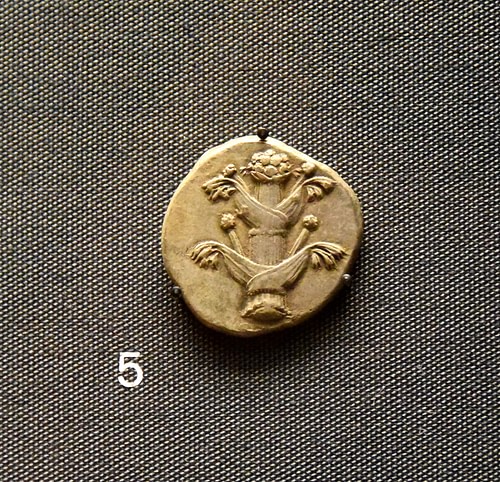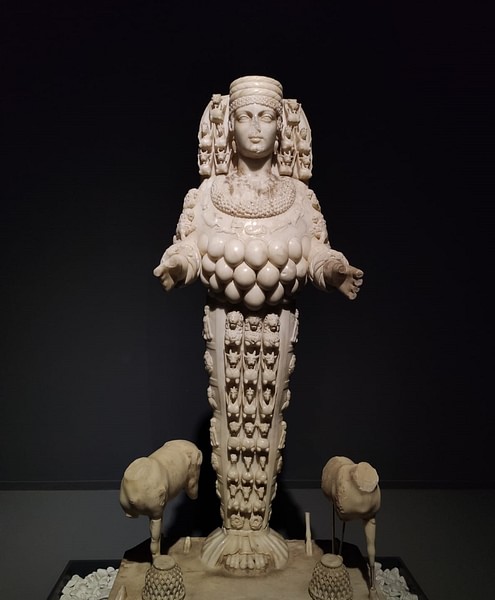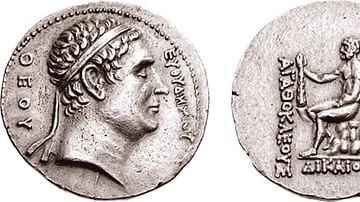Family planning was a topic of vital importance in the ancient Mediterranean. Some of the earliest medical literature from ancient Greece and Rome deals with fertility and reproductive health. Among the numerous treatments and procedures utilized in Greco-Roman medicine were methods of contraception and abortion.
Societal pressure meant that most people married and had children at a fairly young age. However, not everyone chose to have children, and those who did still had to decide how many and when. These decisions were even more important for women, who bore the heaviest burden when having children. Before the advent of modern medicine, pregnancy was frequently a matter of life or death. For unmarried and disadvantaged women, having children could also mean social or financial ruin.
Greco-Roman religious and philosophical thought encompassed a variety of beliefs, and there was no widespread condemnation of either contraceptives or abortion. Legally, there were few regulations preventing access to birth control. However, the options available to women were limited by patriarchal social expectations and the extent of medical knowledge.
Pregnancy in the Ancient Mediterranean
Pregnancy was dangerous in the ancient world due to relatively primitive prenatal care and obstetric medicine. Malnutrition and disease caused elevated rates of miscarriage and other complications during pregnancy. It is estimated that in premodern societies there were an average of 25 maternal deaths for every 1,000 live births. The level of infant mortality was even higher, with perhaps 1/3 of children dying during infancy.
Roman and Greek medicine combined anatomical knowledge, empirical evidence, and spiritual beliefs. Physicians like Galen (129 to c. 216 CE), who rejected superstitious folk remedies, were in the minority. The quality of medical care varied, as there was no oversight to ensure that physicians and midwives performed medical care up to an agreed-upon standard. Women who could not afford to hire a physician or who lived in rural areas had even more difficulty accessing quality medical care.
Another factor which contributed to a high rate of maternal and infant mortality was the young age at which many women became mothers. Women in the ancient Mediterranean typically married between 15 and 22 years old, although marriage as young as 12 was not unusual. Ancient physicians were aware of the connection between youth and maternal mortality and warned against the marriage of extremely young girls. In Sparta, women were not allowed to marry before the age of 18 out of concern for the health of both mother and child. Despite these risks, cultural expectations meant that women were often encouraged to marry and produce children as soon as possible.
Although many physicians understood that there were natural causes underlying medical conditions, the majority of people viewed disease as the result of supernatural forces. Pregnant women were given amulets to protect them from malicious forces. Deities associated with marriage and midwifery, such as Artemis, Hera, and Eileithyia, were specifically invoked to protect women during childbirth.
(In)fertility & Greco-Roman Medicine
Having children was an important milestone in the average person's life and was a way to guarantee that they would have someone to support them in old age. Just as importantly, having offspring was meant to further the family legacy, and contribute useful future citizens to society. Infertility could be a source of social shame, and even grounds for divorce. As early as the 5th century BCE, it was understood that infertility affected both men and women. It was considered to be a more serious deficiency in women than in men, so ancient medical inquiry focused on women.
A number of supposed causes and treatments for infertility were recorded by authors like Hippocrates (c. 5th-6th century BCE), Herophilos (335-280 BCE) Lucretius (c. 99-55 BCE) and Pliny the Elder (23-79 CE). Greco-Roman physicians identified factors such as overall health, lifestyle, age and predisposition which could affect fertility, but reproductive anatomy was still poorly understood. Physicians commonly prescribed treatments which included dietary changes, purging, fasting, bathing, and medicines. Fumigating a patient's nostrils or other orifices was sometimes used to test fertility or to draw a "wandering womb" back into its proper position.

Although the majority of surviving literature was authored by men, women's health issues were largely treated by midwives and other women with medical experience. Male physicians were only summoned in the most serious of circumstances. Scholar Nancy Demand writes:
Traditionally, the care of women in pregnancy and childbirth was in the hands of women, who not only assisted in deliveries but also provided advice about fertility, abortion, contraception, and even (in imagination if not in reality) sex determination. (Demand, 63)
Many people sought out divine intervention when faced with fertility issues. In ancient Greece, it was customary to consult oracles on important matters such as child-rearing. As with other health issues, people who struggled with fertility issues gave offerings to the gods in the hopes of gaining their favour. Votive offerings made of terracotta were often left at temples and were made in the shape of the affected organ or limb. Women left uterus-shaped offerings, while phallic offerings may have been left by men with reproductive difficulties. Women who were pregnant or trying to become pregnant also wore uterine amulets made of hematite, a blood-colored stone associated with fertility.
Contraceptive Use
While some people struggled to conceive, others wanted to avoid pregnancy. Although gynaecological texts primarily concern themselves with inducing pregnancy, many of them also describe ways to prevent conception. Contraceptives were used by both married and unmarried women in the ancient world for reasons pertaining to health, personal preference, and financial stability. Some women wanted to forgo childbirth entirely, while others wanted to limit the size of their family once they had the desired number of children.
Contraceptives were considered to be safer for women than abortion, because of the risks involved with more invasive procedures. Because of this, the physician Soranus (c. 1st-2nd century CE) considered it the ideal method of family planning. Contraceptive methods in the ancient world spanned everything from magic to folk medicine and treatments administered by physicians. The relative sophistication of Greco-Roman contraceptive medicine was noted by scholar Keith Hopkins:
Some of the methods advocated by Greek and Roman doctors could have been very effective, and aspects of ancient contraceptive theory were as advanced as any modern theory before the middle of the 19th century. (Hopkins, 1)
Avoiding pregnancy was considered to be primarily the woman's responsibility, and most contraceptives were used or administered by women. The most common contraceptive method for women was tracking their menstrual cycle to avoid conception. However, Greco-Roman misconceptions about the menstrual cycle meant that this was highly ineffective. Another popular method of contraception were medicinal wines prepared by physicians or midwives. These draughts contained various metals and plants believed to prevent pregnancy. Copper compounds, as recommended by Hippocrates, are still utilized in modern contraceptive medicine.
Some of the plants prescribed by ancient physicians, including pennyroyal, acacia, hellebore, and squirting cucumber, are also known to have contraceptive effects. The most widely used contraceptive herb was silphium, a now-extinct plant which was exported from Cyrene. Silphium was extremely valuable and could be worth its weight in silver. It is frequently featured on ancient Cyrenean coins, referencing its importance to the city's economy. Because of its many uses in medicine and food, it was widely depicted in literature and art.

Other methods included suppositories and forms of barrier protection, such as sponges soaked in vinegar, oil, or cedar resin. Some ingredients used may have had spermicidal properties, but most were ineffective. Magical amulets and protective spells were also sometimes worn or placed on the body to ward off pregnancy. Typically, women would use a variety of contraceptive methods, making it difficult to know which methods were most effective. When these methods failed, some women attempted to terminate their pregnancies through medical or magical means.
Abortion
Abortion was legal in the ancient Mediterranean, with very few restrictions. Although the rights of women in ancient Greece and Rome were limited, abortion was one area where it appears some bodily autonomy existed. Under most legal codes, fetuses were not considered to be autonomous beings with rights separate from the woman's body. As a result, abortion was encouraged as an option for unwanted pregnancies, especially ones that placed the woman's wellbeing at risk. According to John M. Riddle:
According to convention and the law, ancient women could employ contraceptives and early stage abortafacients virtually without consequences. The same was true in Medieval Islam and to some degree in Christian society during the Middle Ages. (Riddle, 23)
The religious belief that life began at conception was not widespread, and there is no evidence that it was ever codified into law. The most widely held position, advocated by Aristotle (384-322 BCE), was that fetuses gradually developed into living beings. Some schools of Greek philosophy differed on that point; Pythagorean philosophy claimed that life began at conception, while Stoic philosophy held that life began at first breath. In the ancient Mediterranean, no single philosophical or religious dogma ever prevailed, allowing individuals to express differing viewpoints.
Greek and Roman medical literature describes several methods of abortion, including poisons, medicated baths, suppositories, extreme physical exertion, and surgery. As with all major medical procedures in antiquity, abortion could be dangerous for the patient. Physicians typically reserved surgical abortions for late-term pregnancies, after less invasive methods had failed. Midwives performed the majority of abortions, but most surviving evidence of their methods was written by male physicians such as Soranus and Celsus (c. 2nd century CE).
Hippocrates described various methods of abortion in his treatise On the Nature of the Child, including surgical procedures to terminate non-viable pregnancies. The Hippocratic Oath, which likely developed after the lifetime of Hippocrates, requires a physician to swear that he would not provide an abortive pessary to a pregnant patient. This created some controversy for later Greek and Roman physicians, who debated whether the prohibition applied to pessaries or abortion in general. Harsh pessaries were noted to be dangerous in medical literature at the time, because of their potential to cause injury to patients. This may have been why the Hippocratic Oath singled out pessaries as a prohibited treatment. The most widely used modern translation of the Hippocratic Oath modified it to prohibit all abortions, however, this does not reflect the meaning of the original text.
The only known legal restrictions placed on abortion were explicitly intended to control women's reproductive potential. In some ancient Greek city-states, including Milos and Athens, a married woman could only obtain abortions with the approval of her husband. Similar laws were introduced in the Roman Empire during the reigns of Septimius Severus (r. 193-211 CE) and Caracalla (r. 211-217 CE). Abortion was criminal in those cases because it deprived a husband of an heir without his permission, not because it was considered to be murder. These laws treated both the woman's body and any potential offspring she might have as the property of her husband. During the reign of the first Roman emperor Augustus (r. 27 BCE to 14 CE), new policies were introduced to encourage couples to have multiple children, while discouraging the use of abortive herbs or contraception. These policies were intended to increase the birth rate among the patrician class, which had been steadily declining. However, abortion was not outlawed and remained a popular method of family planning.
Negative attitudes towards abortion are present in several works of Roman literature, most famously in the satires of Ovid (43 BCE to 17 CE) and Juvenal (c. 55-138 CE). These works focused on espousing the evils of uncontrolled female sexuality. For example, Seneca (4 BCE to 65 CE) and Favorinus (c. 80-160 CE) criticized abortion by associating it with decadence and promiscuity. Some Greek physicians felt that abortions should not be provided to women who committed adultery and wanted to hide extramarital pregnancies, reflecting similar fears of sexual immorality. In the early Roman Empire, laws targeting women who dealt in magic and poisonous medicines were sometimes used to prosecute midwives who made abortive draughts.
Unwanted Children
For a variety of reasons, there were times when parents in ancient Greece and the Roman Empire chose to abandon unwanted infants in public places or in the wilderness. This practice is today termed infant exposure, and was widespread in many ancient societies. The motivations behind infant exposure included religious, social, and economic pressures. One of the most common motivations for infant exposure was poverty. Having to support an additional household member could mean starvation for poor households, making infant exposure a survival strategy. During periods of famine, plague, or social unrest, infant exposure became more common. In the most extreme circumstances, the state provided monetary and food aid to families in an attempt to prevent the widespread abandonment or sale of children.
Social pressure was another reason why some infants were abandoned. Despite the existence of abortion and various forms of birth control, many women were unable to prevent unwanted pregnancies. The social stigma attached to having a child out of wedlock could ruin a woman's reputation, and in some Greek city-states, even threaten her legal standing. Men who suspected their wives of adultery could choose to abandon an infant of uncertain paternity, as a way to avoid raising another man's child or leaving an inheritance to them. Enslaved people could also be compelled to abandon their children at the whim of their owner.
Another motive which has been widely debated by modern historians is the alleged abandonment or infanticide of children with physical abnormalities. The extent of this practice in city-states such as Sparta has been greatly exaggerated, but it is true that infants with physical defects were sometimes exposed. Infants born with obvious abnormalities were considered to be portents of divine punishment, and as such were at times shunned by the community.
Exposed infants often met grim outcomes, but parents could hope that they would be taken in by someone else. Ancient parents had as much love and affection for their children as their modern counterparts, but they lived in a very different societal context. By abandoning their children to an unknown fate, they could avoid the guilt of directly committing infanticide. Some foundlings were adopted by families, while others were enslaved. The potential complications which could arise when an abandoned child's true identity became known later in life was a popular trope in Greek drama. Infant exposure also plays a pivotal role in mythological and legendary traditions, such as the Roman legend of Romulus and Remus, or the story of Atalanta in Greek mythology.
Infant exposure also occurred among the upper classes, either to protect the family's honour from illegitimate pregnancy or to prevent an inheritance from being divided among too many heirs. In 8 CE, Augustus ordered the exposure of his newborn grandson because he was the product of an extramarital affair involving his daughter Julia Minor (19 BCE to 29 CE). Claudius (r. 41-54 CE) controversially rejected the daughter of Plautia Urgulanilla, his former wife, and had the infant exposed.
Men may have preferred infant exposure to abortion, as it allowed them to have a greater level of control over the outcome. While abortion and contraception were controlled by women, the decision of whether to raise a child was the father's. Archaeological and literary evidence indicates that in parts of Greece and Hellenistic Egypt, daughters may have been abandoned more frequently than sons, a preference driven by the patriarchal structure of Greek society.
Late Antiquity
Attitudes toward contraception and family planning began to change during the 2nd and 3rd century CE, as Christianity spread throughout the Roman Empire. The Christian concept of human sexuality as sin led to a general condemnation of contraceptives by religious authorities. Despite this, both Christian and pagan women continued to use contraception out of preference and necessity.
Early Christian responses to abortion were mixed. Theologians debated at what point life began, and under what circumstances abortion was religiously permissible. Many made exceptions where it was necessary to protect the wellbeing of the mother, following established Jewish doctrine. Early-term abortion was often condoned, as many Church Fathers did not consider fetuses to be alive until fully formed, echoing earlier Greek philosophical beliefs.
The Christian apologist Tertullian (c. 155-220 CE) is considered to be the first author to condemn abortion at all stages of pregnancy. However, Tertullian's rhetoric on abortion varied considerably depending on context, making his actual views somewhat opaque. Augustine of Hippo (354-430 CE) condemned abortion, but made a distinction between early-term abortions and late-term abortions, only the latter of which involved killing in his opinion.
Infant exposure continued to be widespread in the Roman Empire, as other methods of limiting family size were discouraged by the church. Recognizing that unwanted children were a social issue, attempts were made to end the practice. In spite of religious and moral objections to the abandonment of children, there was insufficient social support in place to care for them. In 313 CE, Constantine I (r. 306-337 CE) attempted to reduce the number of unwanted children by making it legal for parents to sell infants into slavery and preventing parents who had exposed their infants from reclaiming them. Infant exposure was eventually made illegal in the Roman Empire in 374 CE but continued to be prevalent enough that Justinian (r. 527-565 CE) outlawed the enslavement of exposed infants in 529 CE.













